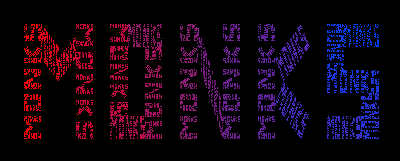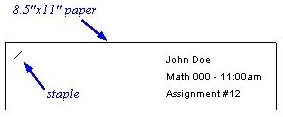Math 320 Syllabus
Course: Chaos and Fractals (CRN31504)
Term: Spring 2011
Time and Place: T-Th, 4:00-5:15, STT314
Instructor: Dr. Ken Monks
Office: STT163A
Phone: (570) 941-6101
Email: monks@scranton.edu
Office Hours: T-Th 5:15-6:00pm and 7:15-whenever we finish (in STT314 or
STT163A)
Highly Recommended Textbook:
- Peitgen, H.,Jurgens, H., Saupe D.;Chaos and Fractals, Springer-Verlag, (second edition) ISBN: 0-387-20229-3
Highly Recommended Software:
- Maple 14 - we will use Maple extensively in this course. Maple is available in most public computer labs on campus. However, it may be more convenient for you to purchase your own copy. Math majors will find it to be quite useful in other courses beyond our own. I have arranged with Maplesoft for you to be able to purchase Maple at a substantial discount. Simply click here and follow the instructions.
- Mandelbrot, B.; Fractal Geometry of Nature, W. H. Freeman, ISBN:0-7167-1186-9
- Barnsley, M.; Fractals Everywhere, Academic Press, 1988, ISBN:0-12-079062-9
- Devaney, R., A First Course in Chaotic Dynamical Systems, Addison-Wesley, 1992, ISBN: 0-201-55406-2
Course Objective: To introduce the student to the beauty, magic, and applications of fractal geometry and chaos theory, with emphasis on the mathematics behind it all. This course is designed for students who have had some calculus and basic linear algebra in mathematics, science, computer science, and engineering majors and related fields. This will be accomplished primarily by covering the material in the course lecture notes and any supplementary material presented by the instructor. Click here to see an outline of the topics I hope to cover. We will use a mixture of hand computations, computer experiments, and mathematical proofs to explore the topics at hand. As a result, students will be required to do calculations, computer projects, and read and write some mathematical proofs. Exams will generally be designed to see if these three objectives are being met.

Attendance Policy: You will be expected to both attend and participate in every scheduled meeting of this course. Should you miss a class for any reason, you are still responsible for all announcements made and all material presented during that class.
Email and the Web: All students in this course are required to have a university computer account and are expected to check their email frequently for announcements and other information I may send to you. Each student is also expected to be able to access any information that I post on the world wide web which is related to your course. You may access this information from the mathematics department computer lab in STT162. Contact the Help Desk in the computer center if you need assistance.
Homework: Due to the large volume of homework I assign and the large number of students in all of my courses, I must insist that all homework satisfies the following criteria:
- All homework must be done on 8.5"x11" paper. The paper must have straight smooth edges, not the jagged edges that are obtained when paper is removed from a "spiral bound" notebook. The paper should not be folded.
- All homework that consists of more than a single sheet of paper must be stapled in the upper left hand corner. Corners should not be folded or "dog eared".
- All homework must have the following information written legibly in
the upper right hand corner of the first page:
- Name
- Course and time
- Assignment number (this is the assignment number given on the assignment sheet, not the number of assignments you handed in).
Thus, the first page of every homework assignment should look like this:

Any homework that does not conform to the above format may be discarded!
The homework that you hand in may not be returned to you until the end of the semester, so if you want to keep a copy for yourself you should make a photocopy before handing it in. If you are handing in more than on Assignment number on a single day, each assignment must be stapled and labeled separately. Failure to follow these procedures will result in you not getting credit for all of your assignments.
Late Assignments: Don't even think about it. I have yet to accept one and don't want to spoil my record. You will receive no credit for late assignments. I also will not accept EARLY assignments. Written or printed assignments must be handed in, in class, on the day they are due, during the first three minutes of class. Computer programs or Maple worksheets can be sent to me as an email attachment as long as it is CLEARLY LABELED as to which assignment it is and sent before the deadline. The subject line for your email message should be "[Chaos] - Assignment ## - lastname" where ## is replaced by your assignment number and lastname is replaced by your last name. If your program is too large to attach to an email message, let me know and we will arrange some other method of delivery. There are NO exceptions. You may not place a homework assignment under my office door or give it to me in the halls or mail it to me or have an uncle deliver it to my house.
Make up exams: If you miss an exam for a valid reason I will discuss make-ups with you at that point. The determination of whether a reason is valid or not will be made by me on a case by case basis. If I determine the reason is not valid you will receive a 0 for that exam. Thus you should check with me BEFORE missing an exam to determine if your reason is valid or not.
Collaboration: All questions
on each assignment can be done either individually or collaboratively
as teams of two or more. If you discuss a problem with another
student, that student becomes your collaborator on that question and
you must write their name at the top of your question like
this:
#5 (Team: John Doe, Mary Smith)
This indicates that you spoke to John Doe, and Mary Smith about
problem #5 (do not include your own name in the Team: list, since
your name is on the front of the assignment). Similarly, John
and Mary would list you, and each other, on their problem #5 as team
members. Note that it does not matter how much or how little
you discuss on a particular problem. Whether you work out the
solution entirely together and read each other's write ups, or simply
ask for a small hint from another student, each of you must list
the other as a collaborator on that problem. When working on a
problem as a team, each member of the team must still write up their
own solution, even if the solutions of all team members are
identical. Credit for a correct problem that is selected to be
graded will be shared equally among all team members (see grading
policy below).
If, in my opinion, a solution to a question has been
shared or copied or discussed by more than one student who do NOT
list each other as team members on their question, I will lower the
final grade in the course by one letter grade for each person
involved and for each occurrence.
Thus, it is in your best interest to follow the following
guidelines regarding doing your homework. If you can get a
question entirely correct on your own, you should do so without
talking to anyone else, otherwise your credit for that question will
be divided by the number of members on your team. However, if two or
more students are really stuck on a question and are not going to be
able to get it by themselves and want to team up to try to answer it
together, then it would be in their best interest to do so since they
would receive at least some partial credit instead of no credit at
all. So if you can get it by yourself, you should, and if you
can't, find someone else who can't and work together.
Any acts of cheating on assignments or exams which come
to my attention will be dealt with in the most severe manner possible
under University guidelines. Plus I will be really upset!
Grading: We will have a midterm exam and a cumulative final exam. We will also have homework assignments, quizzes, and other projects which may include a term project. The Other Grades category will come from randomly selected homework problems and unannounced in-class quizzes. All other homework will not be graded (but must be handed in since you will not know beforehand which problems will be randomly selected to be graded.) You will also be required to participate in class, discuss the material and make presentations if necessary.
The course grade will be determined as follows.
Final Exam - 35%
Midterm - 30%
Other Grades - 35%
Your numerical grade it will then be converted to a letter grade based on
the following table.
| If your numeric grade is greater than or equal to.. |
Your letter grade will be... |
| 93 | A |
| 89 | A- |
| 85 | B+ |
| 82 | B |
| 78 | B- |
| 74 | C+ |
| 70 | C |
| 67 | C- |
| 63 | D+ |
| 60 | D |
| 0 | F |
This will be the grade you receive for the course. I reserve the right to give grades which are not consistent with this grading formula in extreme circumstances and to modify this grading policy during the term if I feel it is in the best interest of the students.
Remember that the only way to really learn mathematics is by doing it yourself. This is the best way to prepare for your exams.
I hear and I forget.
I see and I remember.
I do and I understand
- Chinese Proverb
Schedule: A rough idea of our schedule and pace can be obtained by looking at the proposed list of assignments and the course lecture notes, but the pacing may be adjusted as we proceed. I will announce all exams in class at least one class period before they occur.
Adaptability: I retain the right to modify or change any of the policies stated in this syllabus during the term if I feel it is in the best interests of the students and the course.
